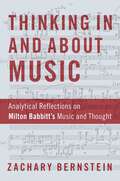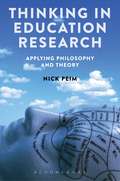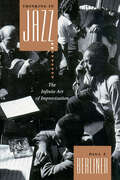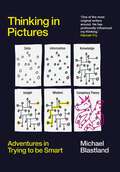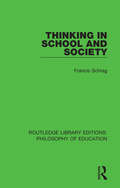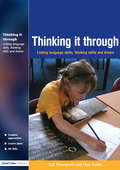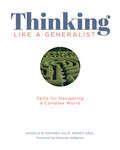- Table View
- List View
Thinking In and About Music: Analytical Reflections on Milton Babbitt's Music and Thought
by Zachary BernsteinMilton Babbitt (1916-2011) was, at once, one of the century's foremost composers and a founder of American music theory. These two aspects of his creative life--"thinking in" and "thinking about" music, as he would put it--nourished each other. Theory and analysis inspired fresh compositional ideas, and compositional concerns focused theoretical and analytical inquiry. Accordingly, this book undertakes an excavation of the sources of his theorizing as a guide to analysis of his music. In Thinking In and About Music, author Zachary Bernstein shows how Babbitt's idiosyncratic synthesis of ideas from Heinrich Schenker, analytic philosophy, and cognitive science--at least as much as more obviously relevant predecessors such as Arnold Schoenberg--provide insight into his aesthetics and compositional technique. At the same time, a close look at his music reveals a host of concerns unaccounted for in his theories, some of which seem to directly contradict theoretical expectations. Bernstein argues, therefore, that new analytical models are needed to complement those suggested by Babbitt's theories. Departing from the serial logic of most previous work on the subject--and in an attempt to discuss Babbitt's music as it is actually heard rather than just deciphered--the book brings to bear theories of gesture and embodiment, rhetoric, text setting, and temporality. The result is a richly multi-faceted look at one of the twentieth century's most fascinating musical minds.
Thinking In and About Music: Analytical Reflections on Milton Babbitt's Music and Thought
by Zachary BernsteinMilton Babbitt (1916-2011) was, at once, one of the century's foremost composers and a founder of American music theory. These two aspects of his creative life--"thinking in" and "thinking about" music, as he would put it--nourished each other. Theory and analysis inspired fresh compositional ideas, and compositional concerns focused theoretical and analytical inquiry. Accordingly, this book undertakes an excavation of the sources of his theorizing as a guide to analysis of his music. In Thinking In and About Music, author Zachary Bernstein shows how Babbitt's idiosyncratic synthesis of ideas from Heinrich Schenker, analytic philosophy, and cognitive science--at least as much as more obviously relevant predecessors such as Arnold Schoenberg--provide insight into his aesthetics and compositional technique. At the same time, a close look at his music reveals a host of concerns unaccounted for in his theories, some of which seem to directly contradict theoretical expectations. Bernstein argues, therefore, that new analytical models are needed to complement those suggested by Babbitt's theories. Departing from the serial logic of most previous work on the subject--and in an attempt to discuss Babbitt's music as it is actually heard rather than just deciphered--the book brings to bear theories of gesture and embodiment, rhetoric, text setting, and temporality. The result is a richly multi-faceted look at one of the twentieth century's most fascinating musical minds.
Thinking in Education Research: Applying Philosophy and Theory
by Nick PeimThinking in Education Research examines the resources available from philosophy and theory that can be practically applied to any educational research project. Nick Peim argues that the current well-established divide between theory and the empirical in research methods is unhelpful to students. Instead, Thinking in Education Research looks at major lines of thinking in modern European philosophy, from Kant to Freud and Derrida to Malabou, and how they provide a rich resource for every stage of conducting research. By getting students engaged in 'how to think' and 'how to do', Peim illustrates that thinking is in fact a vital part of how you do research and is not an aside.Essential aspects of the research endeavour are re-examined in the light of key philosophical positions to offer constructive potential, including:- defining the object; - giving an account of the field;- the relation to truth;- the process of writing and constructing a case; and- the value attributed to formal knowledge. Thinking in Education Research does not try to resolve the unresolved issues of research thinking but rather encourages readers to productively engage with them so that we can enhance the possibilities of research practice and find opportunities for its expansion and refinement. Throughout the chapters, clear and concise summaries of key philosophical positions and ideas are complemented with boxed accounts of how the philosophical debates discussed can be applied to real research projects. These features encourage the reader to consider how they can develop thinking and apply theory at every stage of their own research. This is essential reading for any educational research methods student or practicing researcher for important ways of thinking afresh about research methodology.
Thinking in Education Research: Applying Philosophy and Theory
by Nick PeimThinking in Education Research examines the resources available from philosophy and theory that can be practically applied to any educational research project. Nick Peim argues that the current well-established divide between theory and the empirical in research methods is unhelpful to students. Instead, Thinking in Education Research looks at major lines of thinking in modern European philosophy, from Kant to Freud and Derrida to Malabou, and how they provide a rich resource for every stage of conducting research. By getting students engaged in 'how to think' and 'how to do', Peim illustrates that thinking is in fact a vital part of how you do research and is not an aside.Essential aspects of the research endeavour are re-examined in the light of key philosophical positions to offer constructive potential, including:- defining the object; - giving an account of the field;- the relation to truth;- the process of writing and constructing a case; and- the value attributed to formal knowledge. Thinking in Education Research does not try to resolve the unresolved issues of research thinking but rather encourages readers to productively engage with them so that we can enhance the possibilities of research practice and find opportunities for its expansion and refinement. Throughout the chapters, clear and concise summaries of key philosophical positions and ideas are complemented with boxed accounts of how the philosophical debates discussed can be applied to real research projects. These features encourage the reader to consider how they can develop thinking and apply theory at every stage of their own research. This is essential reading for any educational research methods student or practicing researcher for important ways of thinking afresh about research methodology.
Thinking in Jazz: The Infinite Art of Improvisation (Chicago Studies in Ethnomusicology)
by Paul F. BerlinerA landmark in jazz studies, Thinking in Jazz reveals as never before how musicians, both individually and collectively, learn to improvise. Chronicling leading musicians from their first encounters with jazz to the development of a unique improvisatory voice, Paul Berliner documents the lifetime of preparation that lies behind the skilled improviser's every idea. The product of more than fifteen years of immersion in the jazz world, Thinking in Jazz combines participant observation with detailed musicological analysis, the author's experience as a jazz trumpeter, interpretations of published material by scholars and performers, and, above all, original data from interviews with more than fifty professional musicians: bassists George Duvivier and Rufus Reid; drummers Max Roach, Ronald Shannon Jackson, and Akira Tana; guitarist Emily Remler; pianists Tommy Flanagan and Barry Harris; saxophonists Lou Donaldson, Lee Konitz, and James Moody; trombonist Curtis Fuller; trumpeters Doc Cheatham, Art Farmer, Wynton Marsalis, and Red Rodney; vocalists Carmen Lundy and Vea Williams; and others. Together, the interviews provide insight into the production of jazz by great artists like Betty Carter, Miles Davis, Dizzy Gillespie, Coleman Hawkins, and Charlie Parker. Thinking in Jazz overflows with musical examples from the 1920s to the present, including original transcriptions (keyed to commercial recordings) of collective improvisations by Miles Davis's and John Coltrane's groups. These transcriptions provide additional insight into the structure and creativity of jazz improvisation and represent a remarkable resource for jazz musicians as well as students and educators. Berliner explores the alternative ways—aural, visual, kinetic, verbal, emotional, theoretical, associative—in which these performers conceptualize their music and describes the delicate interplay of soloist and ensemble in collective improvisation. Berliner's skillful integration of data concerning musical development, the rigorous practice and thought artists devote to jazz outside of performance, and the complexities of composing in the moment leads to a new understanding of jazz improvisation as a language, an aesthetic, and a tradition. This unprecedented journey to the heart of the jazz tradition will fascinate and enlighten musicians, musicologists, and jazz fans alike.
Thinking in Jazz: The Infinite Art of Improvisation (Chicago Studies in Ethnomusicology)
by Paul F. BerlinerA landmark in jazz studies, Thinking in Jazz reveals as never before how musicians, both individually and collectively, learn to improvise. Chronicling leading musicians from their first encounters with jazz to the development of a unique improvisatory voice, Paul Berliner documents the lifetime of preparation that lies behind the skilled improviser's every idea. The product of more than fifteen years of immersion in the jazz world, Thinking in Jazz combines participant observation with detailed musicological analysis, the author's experience as a jazz trumpeter, interpretations of published material by scholars and performers, and, above all, original data from interviews with more than fifty professional musicians: bassists George Duvivier and Rufus Reid; drummers Max Roach, Ronald Shannon Jackson, and Akira Tana; guitarist Emily Remler; pianists Tommy Flanagan and Barry Harris; saxophonists Lou Donaldson, Lee Konitz, and James Moody; trombonist Curtis Fuller; trumpeters Doc Cheatham, Art Farmer, Wynton Marsalis, and Red Rodney; vocalists Carmen Lundy and Vea Williams; and others. Together, the interviews provide insight into the production of jazz by great artists like Betty Carter, Miles Davis, Dizzy Gillespie, Coleman Hawkins, and Charlie Parker. Thinking in Jazz overflows with musical examples from the 1920s to the present, including original transcriptions (keyed to commercial recordings) of collective improvisations by Miles Davis's and John Coltrane's groups. These transcriptions provide additional insight into the structure and creativity of jazz improvisation and represent a remarkable resource for jazz musicians as well as students and educators. Berliner explores the alternative ways—aural, visual, kinetic, verbal, emotional, theoretical, associative—in which these performers conceptualize their music and describes the delicate interplay of soloist and ensemble in collective improvisation. Berliner's skillful integration of data concerning musical development, the rigorous practice and thought artists devote to jazz outside of performance, and the complexities of composing in the moment leads to a new understanding of jazz improvisation as a language, an aesthetic, and a tradition. This unprecedented journey to the heart of the jazz tradition will fascinate and enlighten musicians, musicologists, and jazz fans alike.
Thinking in Jazz: The Infinite Art of Improvisation (Chicago Studies in Ethnomusicology)
by Paul F. BerlinerA landmark in jazz studies, Thinking in Jazz reveals as never before how musicians, both individually and collectively, learn to improvise. Chronicling leading musicians from their first encounters with jazz to the development of a unique improvisatory voice, Paul Berliner documents the lifetime of preparation that lies behind the skilled improviser's every idea. The product of more than fifteen years of immersion in the jazz world, Thinking in Jazz combines participant observation with detailed musicological analysis, the author's experience as a jazz trumpeter, interpretations of published material by scholars and performers, and, above all, original data from interviews with more than fifty professional musicians: bassists George Duvivier and Rufus Reid; drummers Max Roach, Ronald Shannon Jackson, and Akira Tana; guitarist Emily Remler; pianists Tommy Flanagan and Barry Harris; saxophonists Lou Donaldson, Lee Konitz, and James Moody; trombonist Curtis Fuller; trumpeters Doc Cheatham, Art Farmer, Wynton Marsalis, and Red Rodney; vocalists Carmen Lundy and Vea Williams; and others. Together, the interviews provide insight into the production of jazz by great artists like Betty Carter, Miles Davis, Dizzy Gillespie, Coleman Hawkins, and Charlie Parker. Thinking in Jazz overflows with musical examples from the 1920s to the present, including original transcriptions (keyed to commercial recordings) of collective improvisations by Miles Davis's and John Coltrane's groups. These transcriptions provide additional insight into the structure and creativity of jazz improvisation and represent a remarkable resource for jazz musicians as well as students and educators. Berliner explores the alternative ways—aural, visual, kinetic, verbal, emotional, theoretical, associative—in which these performers conceptualize their music and describes the delicate interplay of soloist and ensemble in collective improvisation. Berliner's skillful integration of data concerning musical development, the rigorous practice and thought artists devote to jazz outside of performance, and the complexities of composing in the moment leads to a new understanding of jazz improvisation as a language, an aesthetic, and a tradition. This unprecedented journey to the heart of the jazz tradition will fascinate and enlighten musicians, musicologists, and jazz fans alike.
Thinking in Jazz: The Infinite Art of Improvisation (Chicago Studies in Ethnomusicology)
by Paul F. BerlinerA landmark in jazz studies, Thinking in Jazz reveals as never before how musicians, both individually and collectively, learn to improvise. Chronicling leading musicians from their first encounters with jazz to the development of a unique improvisatory voice, Paul Berliner documents the lifetime of preparation that lies behind the skilled improviser's every idea. The product of more than fifteen years of immersion in the jazz world, Thinking in Jazz combines participant observation with detailed musicological analysis, the author's experience as a jazz trumpeter, interpretations of published material by scholars and performers, and, above all, original data from interviews with more than fifty professional musicians: bassists George Duvivier and Rufus Reid; drummers Max Roach, Ronald Shannon Jackson, and Akira Tana; guitarist Emily Remler; pianists Tommy Flanagan and Barry Harris; saxophonists Lou Donaldson, Lee Konitz, and James Moody; trombonist Curtis Fuller; trumpeters Doc Cheatham, Art Farmer, Wynton Marsalis, and Red Rodney; vocalists Carmen Lundy and Vea Williams; and others. Together, the interviews provide insight into the production of jazz by great artists like Betty Carter, Miles Davis, Dizzy Gillespie, Coleman Hawkins, and Charlie Parker. Thinking in Jazz overflows with musical examples from the 1920s to the present, including original transcriptions (keyed to commercial recordings) of collective improvisations by Miles Davis's and John Coltrane's groups. These transcriptions provide additional insight into the structure and creativity of jazz improvisation and represent a remarkable resource for jazz musicians as well as students and educators. Berliner explores the alternative ways—aural, visual, kinetic, verbal, emotional, theoretical, associative—in which these performers conceptualize their music and describes the delicate interplay of soloist and ensemble in collective improvisation. Berliner's skillful integration of data concerning musical development, the rigorous practice and thought artists devote to jazz outside of performance, and the complexities of composing in the moment leads to a new understanding of jazz improvisation as a language, an aesthetic, and a tradition. This unprecedented journey to the heart of the jazz tradition will fascinate and enlighten musicians, musicologists, and jazz fans alike.
Thinking in Physics: The pleasure of reasoning and understanding
by Laurence ViennotRead this book if you care about students really understanding physics and getting genuine intellectual satisfaction from doing so. Read it too if you fear that this goal is out of reach – you may be surprised! Laurence Viennot here shows ways to deal with the awkward fact that common sense thinking is often not the same as scientific thinking. She analyses examples of frequent and widespread errors and confusions, which provide a real eye-opener for the teacher. More than that, she shows ways to avoid and overcome them. The book argues against over-emphasis on “fun” applications, demonstrating that students also enjoy and value clear thinking.The book has three parts: • making sense of special scientific ways of reasoning (words, images, functions)• making connections between very different topics, each illuminating the other• simplifying, looking for consistency and avoiding incoherent over-simplificationThe book is enhanced with supplementary online materials that will allow readers to further expand their teaching or research interests and think about them more deeply.
Thinking in Pictures: A Sceptic’s Guide to Thinking Clearly
by Michael BlastlandWhy thinking in pictures? Short answer: because the words seem to need help. If you sample the many big ideas books to hit the shelves recently, they all promise a smarter, more rational you. But if the books are that good, why are there so many?Using illustrations and photographs, Michael Blastland shows how pictures can help put ideas to the test, making them vivid, showing them in action. Part guide, part gallery, Thinking in Pictures is a brilliant introduction to smart-thinking - how to use it and when to question it - for anyone trying to make sense of a puzzling world.
Thinking in School and Society (Routledge Library Editions: Philosophy of Education)
by Francis SchragIn this book, first published in 1988, the author integrates relevant ideas from philosophy, psychology, sociology, economics and political science to provide a comprehensive analysis of the problem of education for thinking. Professor Schrag takes account of the classroom as well as the larger society, and includes practical recommendations for creating new settings designed to enhance students’ thoughtfulness.
Thinking in School and Society (Routledge Library Editions: Philosophy of Education)
by Francis SchragIn this book, first published in 1988, the author integrates relevant ideas from philosophy, psychology, sociology, economics and political science to provide a comprehensive analysis of the problem of education for thinking. Professor Schrag takes account of the classroom as well as the larger society, and includes practical recommendations for creating new settings designed to enhance students’ thoughtfulness.
Thinking in Threes: The Power of Three in Writing
by Brian BackmanThis practical resource helps students see the importance of “the rules of three” in writing successful essays. The student-friendly activities in this book give students essay-writing strategies organized in easy-to-remember groups of three. The book includes many activities and games that help point out the importance of the number three in our language.With Thinking in Threes, powerful writing strategies are as easy as 1-2-3! Some of the rules of three explained in this book include:three steps for brainstorming,three “Ps” of a thesis statement,three parts of an essay,three paragraphs in the body of an essay,three ways to connect paragraphs and sentences,three types of evidence to support topic sentences,three qualities of a good example,three things to include in a quotation,three ways to hook the reader in an introduction,three ways to write fluent sentences,three ways to write successful conclusions, andthree phrases for completing a timed writing assignment.The goal of Thinking in Threes is to empower students to write great essays in your classroom!Grade 5-Adult
Thinking in Threes: The Power of Three in Writing
by Brian BackmanThis practical resource helps students see the importance of “the rules of three” in writing successful essays. The student-friendly activities in this book give students essay-writing strategies organized in easy-to-remember groups of three. The book includes many activities and games that help point out the importance of the number three in our language.With Thinking in Threes, powerful writing strategies are as easy as 1-2-3! Some of the rules of three explained in this book include:three steps for brainstorming,three “Ps” of a thesis statement,three parts of an essay,three paragraphs in the body of an essay,three ways to connect paragraphs and sentences,three types of evidence to support topic sentences,three qualities of a good example,three things to include in a quotation,three ways to hook the reader in an introduction,three ways to write fluent sentences,three ways to write successful conclusions, andthree phrases for completing a timed writing assignment.The goal of Thinking in Threes is to empower students to write great essays in your classroom!Grade 5-Adult
Thinking it Through: Developing Thinking and Language Skills Through Drama Activities
by Gill Thompson Huw EvansTeaching should be exciting and creative but an overcrowded curriculum can make this hard for teachers to achieve. Help is at hand with these literacy and numeracy lesson plans that also cover language development, thinking skills, and drama. Thinking it Through allows teachers to customize lesson plans to meet their own needs using the book's accompanying CD as well as assess pupils language abilty with handy photocopiable assessment worksheets. The book will help each child reach their full potential regardless of ability using ideas for differentiation and extension and structure lessons according to national curriculum objectives.
Thinking it Through: Developing Thinking and Language Skills Through Drama Activities
by Gill Thompson Huw EvansTeaching should be exciting and creative but an overcrowded curriculum can make this hard for teachers to achieve. Help is at hand with these literacy and numeracy lesson plans that also cover language development, thinking skills, and drama. Thinking it Through allows teachers to customize lesson plans to meet their own needs using the book's accompanying CD as well as assess pupils language abilty with handy photocopiable assessment worksheets. The book will help each child reach their full potential regardless of ability using ideas for differentiation and extension and structure lessons according to national curriculum objectives.
Thinking Like a Generalist: Skills for Navigating a Complex World
by Angela Kohnen Wendy SaulWhat can we teach kids today that will have utility ten or fifteen years from now? Angela Kohnen and Wendy Saul propose an approach to information literacy that goes beyond the teaching of discreet, easily outdated skills. Instead they use activity to help students build identities as curious individuals empowered to ask their own questions and able to navigate their information-filled world in pursuit of credible answers. A generalist is curious, open-minded, skeptical, and persistent in their quest for information. Thinking Like a Generalist: Skills for Navigating a Complex World demonstrates what it means to take a generalist stance in instruction and provides a set of teaching tools to be able to pass those skills to students'sskills that will transfer beyond the walls of the classroom. Inside you'll find the following: A thorough introduction to what it means to be a generalist, and how to develop the practices and tools that help generalists navigate the world we live inA focus on the teacher becoming a generalist and tips for modeling those practices in the classroomDetailed instructions on how to write a unit of study that emphasizes generalist literacy skills and includes an overview and examples of five different unitsHow to use the authors' read-aloud-think-aloud strategy to orient students to generalist tools and practicesThe ideas, strategies, and examples Thinking Like a Generalist will give you the tools to think like a generalist and then pass that knowledge on to your students, guiding them to become inquisitive, lifelong learners and preparing them for a future that we can't yet imagine.
Thinking Like a Generalist: Skills for Navigating a Complex World
by Angela Kohnen Wendy SaulWhat can we teach kids today that will have utility ten or fifteen years from now? Angela Kohnen and Wendy Saul propose an approach to information literacy that goes beyond the teaching of discreet, easily outdated skills. Instead they use activity to help students build identities as curious individuals empowered to ask their own questions and able to navigate their information-filled world in pursuit of credible answers. A generalist is curious, open-minded, skeptical, and persistent in their quest for information. Thinking Like a Generalist: Skills for Navigating a Complex World demonstrates what it means to take a generalist stance in instruction and provides a set of teaching tools to be able to pass those skills to students'sskills that will transfer beyond the walls of the classroom. Inside you'll find the following: A thorough introduction to what it means to be a generalist, and how to develop the practices and tools that help generalists navigate the world we live inA focus on the teacher becoming a generalist and tips for modeling those practices in the classroomDetailed instructions on how to write a unit of study that emphasizes generalist literacy skills and includes an overview and examples of five different unitsHow to use the authors' read-aloud-think-aloud strategy to orient students to generalist tools and practicesThe ideas, strategies, and examples Thinking Like a Generalist will give you the tools to think like a generalist and then pass that knowledge on to your students, guiding them to become inquisitive, lifelong learners and preparing them for a future that we can't yet imagine.
Thinking Like a Geographer: Lessons That Develop Habits of Mind and Thinking Skills for Young Geographers in Grade 2
by Rebecca M. BurleyThinking Like a Geographer focuses on high-interest, career-related topics in the elementary curriculum related to geography. Students will explore interdisciplinary content, foster creativity, and develop higher order thinking skills with activities aligned to relevant content area standards. Students will develop and practice geography skills, such as reading and creating maps, graphs, and charts; examining primary and secondary sources; and thinking spatially on a variety of scales. Thinking Like a Geographer reflects key emphases of curricula from the Center for Gifted Education at William & Mary, including the development of process skills in various content areas and the enhancement of discipline-specific thinking and habits of mind through hands-on activities. Grade 2
Thinking Like a Geographer: Lessons That Develop Habits of Mind and Thinking Skills for Young Geographers in Grade 2
by Rebecca M. BurleyThinking Like a Geographer focuses on high-interest, career-related topics in the elementary curriculum related to geography. Students will explore interdisciplinary content, foster creativity, and develop higher order thinking skills with activities aligned to relevant content area standards. Students will develop and practice geography skills, such as reading and creating maps, graphs, and charts; examining primary and secondary sources; and thinking spatially on a variety of scales. Thinking Like a Geographer reflects key emphases of curricula from the Center for Gifted Education at William & Mary, including the development of process skills in various content areas and the enhancement of discipline-specific thinking and habits of mind through hands-on activities. Grade 2
Thinking Like a Lawyer: A Framework for Teaching Critical Thinking to All Students
by Colin SealeCritical thinking is the essential tool for ensuring that students fulfill their promise. But, in reality, critical thinking is still a luxury good, and students with the greatest potential are too often challenged the least. Thinking Like a Lawyer:Introduces a powerful but practical framework to close the critical thinking gap.Gives teachers the tools and knowledge to teach critical thinking to all students.Helps students adopt the skills, habits, and mindsets of lawyers. Empowers students to tackle 21st-century problems.Teaches students how to compete in a rapidly changing global marketplace.Colin Seale, a teacher-turned-attorney-turned-education-innovator and founder of thinkLaw, uses his unique experience to introduce a wide variety of concrete instructional strategies and examples that teachers can use in all grade levels and subject areas. Individual chapters address underachievement, the value of nuance, evidence-based reasoning, social-emotional learning, equitable education, and leveraging families to close the critical thinking gap.
Thinking Like a Lawyer: A Framework for Teaching Critical Thinking to All Students
by Colin SealeCritical thinking is the essential tool for ensuring that students fulfill their promise. But, in reality, critical thinking is still a luxury good, and students with the greatest potential are too often challenged the least. Thinking Like a Lawyer:Introduces a powerful but practical framework to close the critical thinking gap.Gives teachers the tools and knowledge to teach critical thinking to all students.Helps students adopt the skills, habits, and mindsets of lawyers. Empowers students to tackle 21st-century problems.Teaches students how to compete in a rapidly changing global marketplace.Colin Seale, a teacher-turned-attorney-turned-education-innovator and founder of thinkLaw, uses his unique experience to introduce a wide variety of concrete instructional strategies and examples that teachers can use in all grade levels and subject areas. Individual chapters address underachievement, the value of nuance, evidence-based reasoning, social-emotional learning, equitable education, and leveraging families to close the critical thinking gap.
Thinking Like a Mathematician: Lessons That Develop Habits of Mind and Thinking Skills for Young Mathematicians in Grade 3
by Mary-Lyons Walk Hanks Jennifer K. Lampert Katherine PlumThinking Like a Mathematician focuses on high-interest, career-related topics in the elementary curriculum related to mathematics. Students will explore interdisciplinary content, foster creativity, and develop higher order thinking skills with activities aligned to relevant content area standards. Students will engage in exploration activities, complete mathematical challenges, and then apply what they have learned by making real-world connections. Thinking Like a Mathematician reflects key emphases of curricula from the Center for Gifted Education at William & Mary, including the development of process skills in various content areas and the enhancement of discipline-specific thinking and habits of mind through hands-on activities. Grade 3
Thinking Like a Mathematician: Lessons That Develop Habits of Mind and Thinking Skills for Young Mathematicians in Grade 3
by Mary-Lyons Walk Hanks Jennifer K. Lampert Katherine PlumThinking Like a Mathematician focuses on high-interest, career-related topics in the elementary curriculum related to mathematics. Students will explore interdisciplinary content, foster creativity, and develop higher order thinking skills with activities aligned to relevant content area standards. Students will engage in exploration activities, complete mathematical challenges, and then apply what they have learned by making real-world connections. Thinking Like a Mathematician reflects key emphases of curricula from the Center for Gifted Education at William & Mary, including the development of process skills in various content areas and the enhancement of discipline-specific thinking and habits of mind through hands-on activities. Grade 3
Thinking Like a Scientist: Lessons That Develop Habits of Mind and Thinking Skills for Young Scientists in Grade 5
by Lenore TeevanThinking Like a Scientist focuses on high-interest, career-related topics in the elementary curriculum related to science. Students will explore interdisciplinary content, foster creativity, and develop higher order thinking skills with activities aligned to relevant content area standards. Through inquiry-based investigations, students will explore what scientists do, engage in critical thinking, learn about scientific tools and research, and examine careers in scientific fields. Thinking Like a Scientist reflects key emphases of curricula from the Center for Gifted Education at William & Mary, including the development of process skills in various content areas and the enhancement of discipline-specific thinking and habits of mind through hands-on activities. Grade 5
